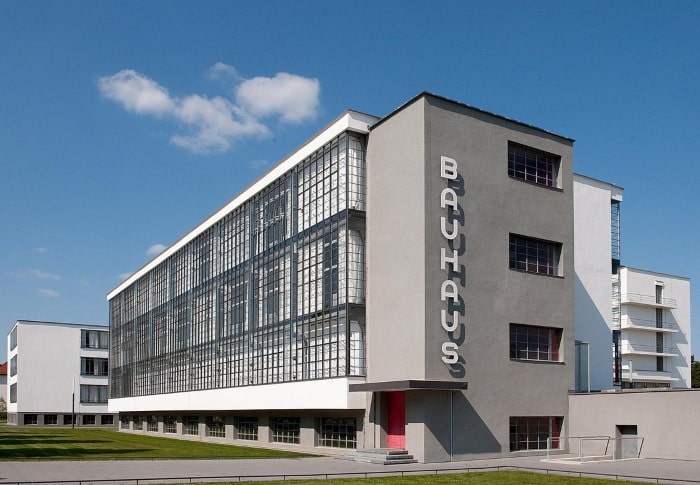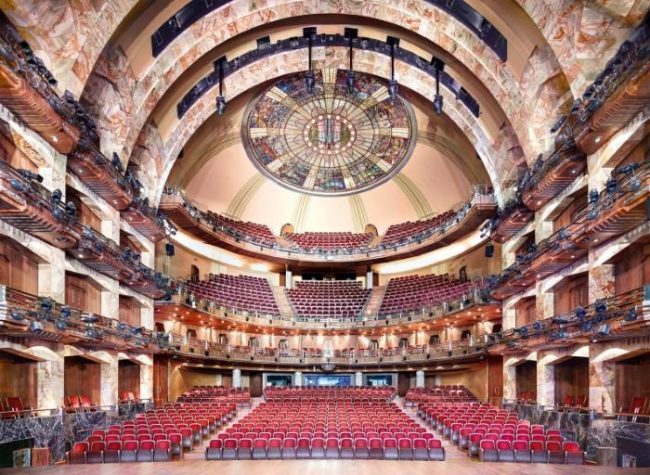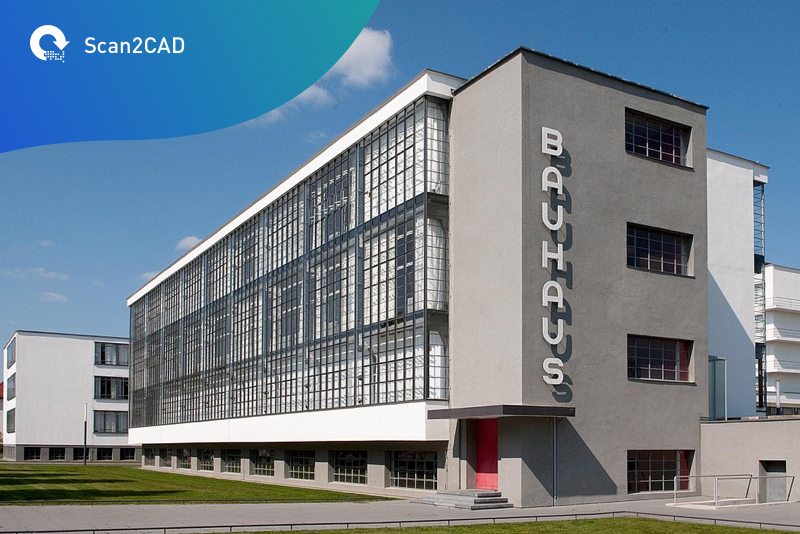Welcome to Scan2CAD’s first news roundup of the year! As we say goodbye to January, we’re looking back at the stories that caught our eye from the fields of architecture, engineering, design and CAD. This month’s roundup features the 100-year anniversary of Bauhaus, the first World Capital of Architecture, what consumers expect of life in 2030 and much more. Without further ado, let’s get started!
100-year anniversary of Bauhaus and its everlasting influence
Established in 1919 in Weimar, German’s Bauhaus art and design school marked a turning point in the approach to design, aesthetics and mass production. The school’s founder, architect Walter Gropius, sought to unite craft and creation. This followed the idea that there should be no distinction between form and function. Students from diverse social and ethnic backgrounds were immersed in hands-on workshops ranging from metalwork to furniture making to typography.
The school later moved to a new base in Dessau—designed by Gropius—in 1925. By 1932, the school was forced to move yet again due to the Nazi Party’s growing control of Dessau. Their move to Berlin wasn’t long successful, however. Soon enough, political pressure against the Bauhaus reached an all-time high. The school was branded “un-German” and was believed to be a front for communists and social liberals. By 1933, Adolf Hitler became Chancellor and the school gave into the pressure to shut down.

Source: Bauhaus Dessau
The closure of the Bauhaus, however, didn’t have the impact intended by the Nazis. Instead of stomping out the movement, they simply aided in its rapid expansion. Key figures involved with the school—including teachers and students—emigrated to countries like the US and Israel. They were then able to spread key philosophies and, ultimately, inspire future generations of architects and designers across the world. Iconic works inspired by Bauhaus include Marcel Breur’s chair designs, Marianne Brandt’s teapot, and Wilhelm Wagenfield’s WA24 Lamp.
Even today, as we celebrate the Bauhaus Centenary, we can still see its influence on modern design and architecture around the world—from Tel Aviv’s White City to Ikea’s furniture to the iPhone. Although a century might have passed since its inception, it’s clear that the minimalist elegance and simplicity associated with Bauhaus is still as important as ever.
Rio de Janeiro named first World Capital of Architecture
On 18 January, UNESCO announced that the city of Rio de Janeiro will be the World Capital of Architecture for 2020. The Brazilian city will be the first to receive this designation from UNESCO. The heritage body worked with the International Union of Architects (UIA) to push for the designation in the hopes that it “will become a global forum for discussion on the pressing challenges of our world”, not to mention developing solutions for the benefit of future generations through culture.
Ernesto Ottone, UNESCO’s assistant director-general, said that the initiative would not only “create new synergies between culture and architecture in an increasingly urban world”, but also ensure that “these cities are also perceived as open and creative spaces for exchange, invention and innovation”. UIA President Thomas Vonier added, “We want to highlight how architects, with the help of local governments and communities can play a key role in identifying solutions that benefit communities.”
UNESCO will designate the World Capital of Architecture every three years. This will coincide with the UIA’s World Congress event. The winning city will host the event and follow a chosen theme. Rio de Janeiro’s 2020 theme is “All the worlds. Just one world”, linking back to Goal 11 of UNESCO and UIA’s Sustainable Development Agenda for 2030: “Make cities and human settlements inclusive, safe, resilient and sustainable”.
Candida Höfer’s In Mexico: 600 years of architecture, culture and design

Source: Sean Kelly Gallery
Due to open in Sean Kelly’s New York Gallery next month, the In Mexico exhibition pulls together the collection of interior architectural photographs taken by German photographer Candida Höfer, during her trip across Mexico in 2015. Renowned for her large-scale color images of empty interiors and social spaces, Höfer toured Mexico as part of the Mexico-Germany Dual Year exchange programme.
During her trip, Höfer traveled across cities like Mexico City and Oaxaca, capturing the interiors of cultural and institutional buildings—including churches, libraries and museums—dating back to the 15th century. From the National Museum of the Viceroyalty of New Spain to the Church of Santo Domingo de Guzmán, Höfer was able to capture over 600 years’ worth of architectural history. The Sean Kelly Gallery praised Höfer’s works for documenting “not only the physical details of these interiors but also […] the spirit and essence of each space”.
Indeed, Höfer’s work is most notably devoid of people. By doing so, she instead draws our attention to the intricate architectural details of each space. When describing her work and the resounding absence of people, Höfer commented that “it became apparent to me that what people do in these spaces—and what the spaces do to them—is more obvious when nobody is present”.
The In Mexico exhibit will run from February 2 to March 16.
Autodesk successfully acquires BuildingConnected
We don’t seem to be able to go to more than a month or so without mentioning one particular CAD powerhouse: Autodesk. In December, Autodesk announced its planned acquisition of BuildingConnected in a move to further bolster their already impressive portfolio. This month, they completed their acquisition for $275 million net of cash acquired.
BuildingConnected currently stands as one of the biggest digital networks in the construction industry—boasting over 700,000 professional users. It allows owners, contractors and subcontractors to streamline their businesses and communication with a suite of preconstruction software tools. Additionally, it enables users to quickly find and select subcontractors, not to mention respond to project opportunities. Notable customers of the platform include Turner Construction, StructureTone and AECOM.
Autodesk’s plan is to fully integrate workflows between BuildingConnected and Autodesk products including BIM 360, Revit and AutoCAD. By doing so, Autodesk hopes to increase construction productivity and make communication across project teams more efficient. Furthermore, they hope to offer a full construction solution that “addresses the critical processes and workflows across the project lifecycle from start-to-finish”.
Dassault Systèmes: life in the city of 2030
During the Consumer Electronics Show (CES), the annual gathering for those in consumer technology, Dassault Systèmes unveiled a study on US consumer expectations in life in the city of 2030. Dassault conducted this study in partnership with CITE Research. CITE asked a series of questions to a sample of 1,000 American consumers on topics such as home, health, travel and retail. Looking at the results, it’s clear that consumers expect an increase of automation in almost every area of their lives.
Artificial Intelligence (AI) plays a heavy role in consumer predictions, with 73% expecting to use remotely monitored appliances at home and 40% believing they’ll be using virtual home robots. When it comes to travel, 63% of consumers expect to be using an autonomous car, 51% expect to travel by hyperloop and 38% believe it’s likely that they’ll be using air taxis by 2030. The most expectation from consumers, however, seems to lie in healthcare, with a strong 83% expecting personalized preventative plans based on nutrition and behavior. Additionally, 81% expect to be using innovative devices to dispense treatments at home.
It’s safe to say that consumers are pretty confident in the upward trajectory of autonomous technology and breakthroughs. With its 3DEXPERIENCE platform, Dassault Systèmes hope to meet these consumer expectations and then some!
More stories we loved this month
Whilst we’d love to discuss every interesting story that caught our eye in January, we simply don’t have the time or space! We would, however, like to highlight a few extra stories that we loved from the world of CAD, architecture and design.
- Business of Architecture interviewed a managing partner of a Vancouver-based architecture firm, giving us a glimpse at how creating a multidisciplinary practice can bring in new opportunities and strengthen relationships with clients.
- We always love to hear about 3D printed-related news, especially when it revolves around improving lives. This month, Osseus Fusion System’s 3D printed titanium spinal implants were implemented successfully for the first time.
- In a particularly interesting opinion piece, Darran Anderson argues that we must develop a new form of architecture to adapt to major environmental changes. Instead of imagining Utopian landscapes based on optimism, “to survive, cities will have to embrace their environmental aspect“.
- We’ll finish off our list with a look to what 2019 might hold for interior design. According to Michelle Ogundehin’s trend report, interior design will see an increase in interest around well-being, comfort and more.

